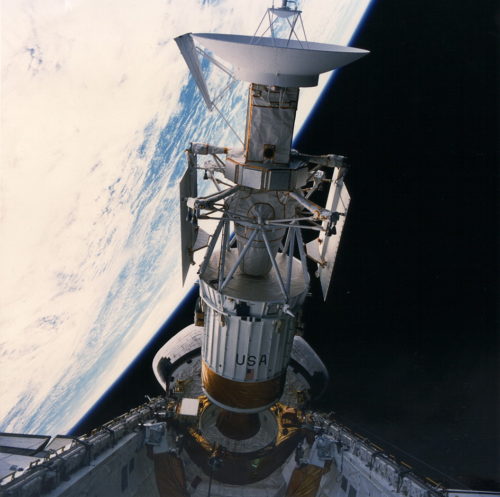
The Magellan spacecraft departs the payload bay on STS-30. At just 97 hours, this mission was the shortest flight in Atlantis’ entire career and the second-shortest operational mission in shuttle program history. Photo Credit: NASA, via Joachim Becker/SpaceFacts.de
Thirty years ago, this week, shuttle Atlantis sat patiently primed on Pad 39B at the Kennedy Space Center (KSC) in Florida, only days away from her fourth voyage into orbit. Veteran astronauts Dave Walker, Ron Grabe, Norm Thagard and Mary Cleave, joined by “rookie” spacefarer Mark Lee, were tasked with a four-day mission to deliver the shuttle program’s first interplanetary emissary—the Magellan radar-mapper—onto a multi-year exploration of Venus.
It was the United States’ first visit to the planet labeled Earth’s “twisted sister” since Pioneer Venus Orbiter, a decade earlier, and it was hoped that Magellan would unravel many of the mysteries of a world so alike our own in terms of proximity and physical size, yet so profoundly dissimilar with regard to temperature and atmospheric structure, composition and pressure. Although Magellan occupied the STS-30 astronauts for only the first few hours of their flight, its astonishing legacy was that by the end of the 1990s more detailed maps were available for parts of Venus than for our own Home Planet.
Cloaked by thick clouds, Venus’ virtually impregnable atmosphere gave very few clues about its surface in the days preceding the Space Age. In the early 1960s it was recognized that radar imaging from Earth could generate crude surface pictures, which allowed scientists to peg the length of the planet’s year and ascertain its retrograde rotation. Efforts to build a Venus Orbiter Imaging Radar (VOIR) came to nothing, due to excessive budgets, but in 1983 a stripped-down variant was recommended by the Solar System Exploration Committee under the revised name of “Venus Radar Mapper” (VRM). Two years later, the mission was formally named “Magellan”, honoring Ferdinand Magellan, the 16th-century Portuguese explorer who mapped and circumnavigated the globe; just as his mechanical namesake would do for Venus. In the months prior to the Challenger disaster, Magellan was slated to launch aboard Mission 81I in April 1988. Pushed away from Earth by a liquid-fueled Centaur-G booster, it would follow a “Type I Heliocentric Orbit” trajectory, carrying it 180 degrees around the Sun to reach Venus four months later.
Following the loss of Challenger, Magellan was re-manifested atop a solid-fueled Inertial Upper Stage (IUS). With the resumption of shuttle flights planned for fall 1988, the next available “window” to reach Venus under the most optimum conditions was in October 1989, but that date was needed by the Galileo spacecraft, whose journey to Jupiter incorporated a Venus gravity-assist. As a result, the trajectory specialists settled on a four-week period from 28 April through 28 May 1989, known as a “Type IV Heliocentric Orbit”. This required Magellan to execute 1.5 orbits of the Sun and arrive at Venus in August 1990.
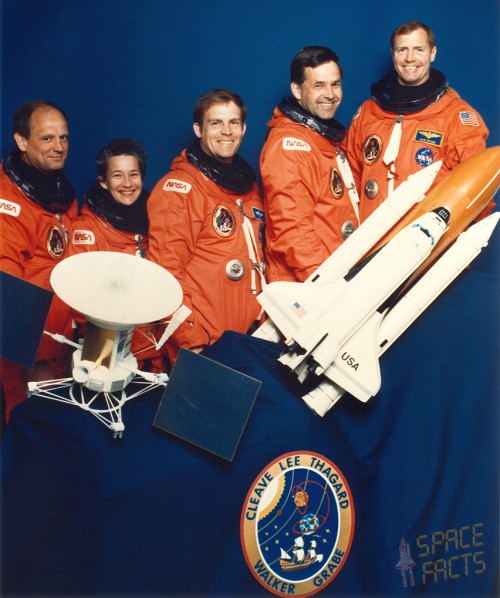
The STS-30 crew of (from left) astronauts Norm Thagard, Mary Cleave, Mark Lee, Ron Grabe and Dave Walker set Magellan free on its 15-month voyage to Venus in May 1989. Photo Credit: NASA, via Joachim Becker/SpaceFacts.de
The STS-30 crew was assigned a year prior to launch, in March 1988. “I never expected to get assigned that fast after the accident,” said Cleave in a NASA oral history, “so I was really surprised when they assigned Mark Lee and I to do this Magellan deployment.” Early in training, Cleave asked Lee where he wanted to fly for ascent; Lee picked the flight deck, so Cleave would sit alone downstairs in the darkened middeck, with only a wall of lockers for company. The bonus, though, was that she could make as much noise as she liked during ascent. “I could hoot, I could holler,” she said, “I could have a marvelous time…and, man, that’s a ride. It’s really a great ride!”
NASA aimed to get Atlantis airborne on 28 April, the first day of the Venus window, but the countdown clock was halted at T-31 seconds when a hydrogen recirculation pump for cooling the shuttle’s three main engines developed a short circuit and stalled. The problem was corrected and STS-30’s launch was rescheduled to occur during a 64-minute window on 4 May. The length of these windows extended from April into May—ranging from 18 minutes on 28 April to 121 minutes on 28 May—and was due, in part, to the need for daylight landing opportunities at the Transoceanic Abort Landing (TAL) sites. It seemed at first that 4 May would also produce a scrub, with dreary, overcast skies and strong crosswinds blowing across the shuttle runway at the Cape.
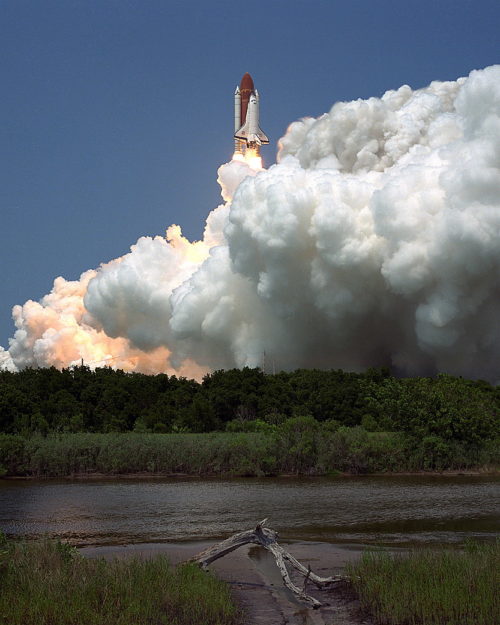
Atlantis roars aloft from Pad 39B on 4 May 1989. Photo Credit: NASA, via Joachim Becker/SpaceFacts.de
Nevertheless, the astronauts suited up and departed for Pad 39B. A hold in the count was called at T-5 minutes, to wait for the weather to improve, which it stubbornly refused to do. Then, with only a handful of minutes remaining in the 64-minute window, the winds dissipated, the clouds parted and the countdown proceeded. Launch occurred at 2:46:59 p.m. EDT. “The attitude in the cockpit was relatively relaxed,” Grabe recalled later. “Of course, there’s a limit to how relaxed you can be when someone lights off that big torch beneath you!” Having flown previously in lightweight flight garments, and on STS-30 in the bulky orange partial-pressure suit, Grabe also noticed that the new ensemble provided a little more “acoustic insulation” for his second launch into space.
Deployment of Magellan got underway almost immediately when Atlantis achieved orbit. In Cleave’s mind, the longer it remained in the shuttle’s payload bay, the more chances existed for problems to develop. As soon as it was gone, and responsibility passed from the Johnson Space Center (JSC) in Houston, Texas, to the Jet Propulsion Laboratory (JPL) in Pasadena, Calif., the crew could breathe easier. “Get rid of this thing,” she told the NASA oral historian, years later. “First day, it’s outta there.” Deployment occurred at 9:01 p.m. EDT, six hours into the flight, and the Magellan/IUS stack drifted serenely into the inky blackness of space at just 0.5 feet (15 cm) per second. From his perspective, Lee was impressed by the reliability of the IUS, which positioned its precious payload very close to its intended parameters. Ten minutes after deployment, Magellan deployed its two paddle-like solar arrays, ahead of the ignition of the IUS.
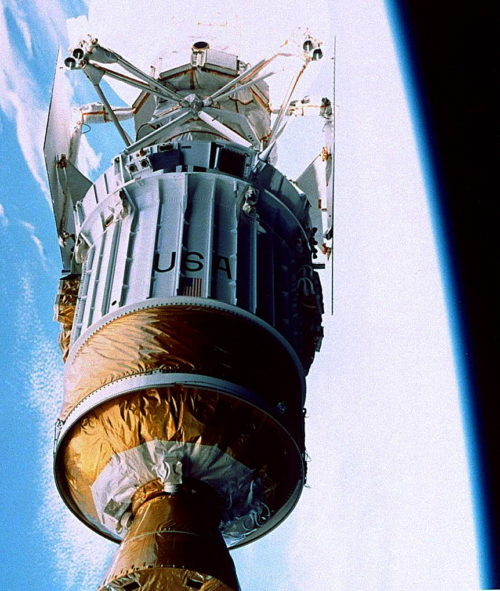
The solid-fuelled Inertial Upper Stage (IUS) provided the muscle to boost Magellan out of low-Earth orbit and onto a course for Venus. Photo Credit: NASA, via Joachim Becker/SpaceFacts.de
All told, two IUS “burns” were required to boost the spacecraft out of low-Earth orbit and onto a course for Venus. Over the next year, Magellan would utilize its own thrusters to fine-tune its trajectory, before arriving at its destination on 10 August 1990. For the next four years, it acquired detailed radar data on craters, volcanoes, flat plains, hills, ridges and other geological formations on Venus. Five “cycles”, each lasting approximately one Venusian year, or 225 Earth-days, were completed, gathering radar and gravitational data, and in the summer of 1994 Magellan was employed for “aerobraking” tests to examine atmospheric densities at various altitudes. It finally burned up in the planet’s hellish atmosphere in October 1994, having mapped 92 percent of the surface.
All this was in the future for the STS-30 crew, who spent the remainder of their four days in orbit performing scientific experiments. On 7 May, one of the shuttle’s General Purpose Computers (GPCs) failed and Cleave and Lee were tasked with replacing it. “We thought our last day on-orbit would be a pretty easy day,” Lee remarked later, “but we ended up changing out the computer.” The tightness of working in the middeck avionics bay to carry out the work was lessened by the fact that, in microgravity, there were few pressure points and Lee found that he could work comfortably for a couple of hours. He and Cleave carefully marked and labeled all of the cables to ensure the accuracy of their work.
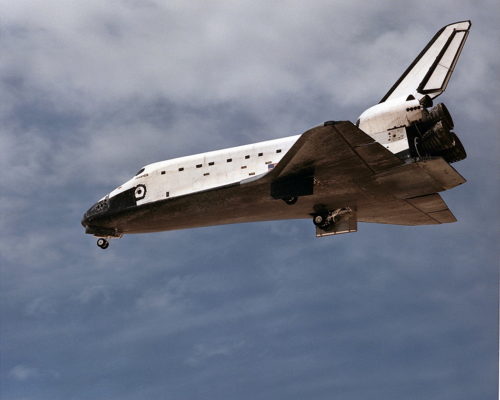
“Ron’s Job”, according to STS-30 Commander Dave Walker, was the deployment of the landing gear, arguably the most critical task done by the pilot. Photo Credit: NASA, via Joachim Becker/SpaceFacts.de
Next day, Walker and Grabe brought Atlantis smoothly to land at Edwards Air Force Base, Calif., wrapping up a mission which remains the second-shortest operational mission of the 30-year shuttle program. In his post-flight remarks, Walker noted that he was “very appreciative” to Grabe for deploying the landing gear, which he labeled as the pilot’s most critical task of the entire mission.
Waiting for the STS-30 crew on Edwards’ runway was NASA Administrator Dick Truly and his deputy, Dale Myers. “We were very happy to be back after what was a very exciting, although to our minds, too short a flight,” Walker reflected. “We would’ve been happy to stay longer. And we’ll be happy to go back when the next opportunity presents itself.”
.
.
FOLLOW AmericaSpace on Facebook and Twitter!
.
.





